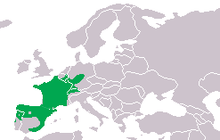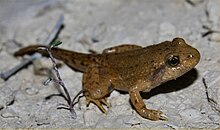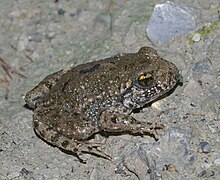Common midwife toad
| Common midwife toad | ||||||||||||
|---|---|---|---|---|---|---|---|---|---|---|---|---|

Common midwife toad ( Alytes obstetricans ), male with fresh egg clutches |
||||||||||||
| Systematics | ||||||||||||
|
||||||||||||
| Scientific name | ||||||||||||
| Alytes obstetricans | ||||||||||||
| ( Laurenti , 1768) |
The common , common or northern midwife toad ( Alytes obstetricans ) is a frog from the family Alytidae . It is the only species of this family whose distribution extends from the southwest to Central Europe. The female midwife toads do not lay their spawn in a body of water. Instead, towards the end of mating, the males take over the newly laid egg cords, attach them to their hind legs and carry them with them until the tadpoles are ripe to hatch.
features
Adult male obstetrician toads are on average 40 mm long, rarely over 50 and a maximum of 55 mm long. In a population in southwest Germany, the size of the sexually mature males varied between 31 and 48 mm. Females are at most slightly larger than males. The body is stocky, the head broad, the muzzle slightly pointed, the pupils are vertical and the ear glands ( parotid ) and eardrum are relatively easy to see. The gray to gray-brown upper side is covered with small, rounded, sometimes reddish warts, the dirty-white underside is usually spotted gray. The spawning males are unmistakable. They have neither vocal sacs nor seasonal heat calluses (see also: Paul Kammerer ).
etymology
The term "midwife toad" probably stems from the fact that it was previously assumed that the male would actively pull the spawning cord out of the female's cloaca with his hind legs in the amplexus (which, however, is not the case). Others lead the name back to the brood care behavior ("spawning") of the male. According to the sound of the calls, another common name is "bell frog" (or, correspondingly regionally, "glögglifrosch" etc.). Another name, "captive toad", refers to the males appearing to be shackled by the spawning. In addition, numerous local names, some of which are hardly in use, are known, including ringing frog, stone latch, stone toad, Möhnli or clinker toad. The above-mentioned interpretations can also be found in the scientific name: Alytos = Greek for "tied up", obstetricus = Latin for "midwife, helping with childbirth". Areas or bodies of water with the occurrence of the midwife toad had names like Klingelsiepen, Klingelborn, Klingelschlade, Klingelpütt, Glockenteich. In the Sauerland there are three legends in which the calls of the midwife toad appear.
distribution and habitat
The species mainly inhabits southwest and western Europe and partly Central Europe. It occurs in the south of the Netherlands, in east Belgium, Luxembourg, France, in parts of Germany, in Switzerland, in north and east Spain and in north Portugal. In Germany it is on the central low mountain range (to the north and east: Lower Saxony Weser-Leine-Bergland , Harz and foreland, western Saxony-Anhalt and western Thuringia, to the south: north and central Hesse, north-western Bavaria) and the western part ( southern North Rhine-Westphalia, Rhineland-Palatinate, Saarland, southwest Baden-Württemberg). While only the nominate form is represented in Central Europe, which was (re) populated only after the Ice Age , the Iberian Peninsula, which has been occupied for millions of years, was able to develop a greater range of variation with several subspecies and other Alytes species.
The rural habitats are heat-favored and at the same time have numerous hiding places that are moist to the ground, e.g. B. under stone slabs, in stone piles or holes in the ground. The right microclimate is a decisive factor in choosing a habitat. The species uses a wide range of sunny to partially shaded bodies of water with different sizes and water flows (small bodies of water, ponds, ponds) as reproductive waters. Often the hiding spots and the waters are close together. Typical year-round habitats in Central Europe are mainly in stone quarries and clay pits with little vegetation , on military training grounds and also in the area of settlements such as gardens and cemeteries. The caves in which midwife toads live are 30–50 cm deep.
Reproductive biology
The call activity of the males extends from March to August (Southwest Germany: April to the end of August) and is divided into three or four call periods by repeated strong decline. During the periods of high acoustic activity, pairings take place over the course of a few days. The greatest calling activity of the males, who always call ashore, occurs in the evening and night hours. The daily call phase begins at dusk, when the brightness has decreased to 140-40 lux. This brightness corresponds to an advanced twilight. At the beginning of April, calling starts at 7.45 p.m., and only around 8.45 p.m. in mid-July due to the changed day length. The midwife toads only call in a certain temperature range. The lower call threshold is 6–7 ° C, the upper 25–26 ° C.
Calls: The males' mating call consists of a sequence of short, harmonic sounds that are pleasant to the human ear and resemble high-pitched flute tones or radio signals. Several call characteristics change with ambient temperature. The repetition rate is relatively low. At 8 ° C the males emit an average of 12.25 sounds per minute, at 25 ° C it is an average of 40. The base frequency for a 40 mm male at 8 ° C is 1375 Hz and increases to 1475 Hz when the Temperature to 25 ° C. Five overtones are regularly formed. Although the sounds are short anyway, their duration continues to decrease as the temperature rises, from 150 ms at 8 ° C to 77 ms at 25 ° C. The size of the animals also has repercussions. With increasing body length, the duration of the sounds increases while the basic frequency decreases.
Unlike most other frogs, female obstetrician toads also have a mating call. It is similar to that of the males, but there are gender-specific differences. The most noticeable is the volume. The sound pressure makes up only about half or even only a quarter of the sound pressure of the calls uttered by the males. The basic frequency is 60–80 Hz above that of the males, who are of the same size and call at the same temperature. The females utter mating calls when they are ready to mate and specifically wander to a calling male. When they have come within 4 meters of this, they begin to call out, often alternating with the selected male.
Mating: Mating takes place on land and takes up to an hour and a half. Specific and coordinated behaviors ensure the safe transfer of the eggs laid by a female to the male involved in the mating. This remarkable process has been the subject of in-depth research several times. When mating begins, the male clasps the female in front of her hind legs with his front legs, then performs rocking movements and brushes the female's cloaca with his hind legs. In response to a body signal from the female, the male moves forward and now clasps the female in front of her front legs. Thereupon, and within one to three seconds, the female lays down two spawning cords that form a tangle. Both animals form a basket with their hind legs in which the eggs given by the female are caught and inseminated by the male. The ingestion of the eggs by the male begins after a rest period of up to 17 minutes. The male, still clutching the female, forces his hind legs through the ball of eggs and spreads his legs wide to the side, causing the eggs to slide over the heel. After repeating this action several times, all the eggs are attached to the rails of the hind legs by the jelly that has dried to form elastic bands. It is sometimes reported that the male wraps the egg cords around his hind legs. According to previous reports, this does not seem to be the case. After about an hour, the female leaves the male, looks for shelter nearby and usually does not return to her own cave until the following night. The male remains in his den and continues to utter mating calls.
Within about two weeks, males can mate with different females and take in a second, rarely a third clutch. Overall, a male usually carries several dozen (extreme values: 5 to 171) eggs with him. The eggs are large, rich in yolk, slightly yellowish immediately after oviposition, later dark brown in color. Compared to other frog species, the number of eggs in a clutch is low. It is sufficient to secure the population as the midwife toads care for the brood. This type of reproductive behavior corresponds to the K-strategy . Depending on the weather, the spawning lines remain with the sire for 20 to 45 (50) days. The eggs are kept moist by high humidity, dew, rain and possibly short stays in water (the latter is only suspected). After the egg ripening, the male goes to the breeding water, where the 12 to 20 mm long and relatively well developed larvae begin to hatch a few minutes after contact with the water. The first larvae are brought into the water from mid-May, males with egg cords were observed until the end of August. Wintering of the tadpoles occurs regularly; such overwintered larvae can sometimes reach a length of 90, exceptionally 110 millimeters.
Midwife toads can reproduce up to three times per year, less often up to four times. Sexual maturity is reached after the second wintering following the metamorphosis . The animals can live to be over eight years old.
Hazard and protection
Midwife toad populations are primarily threatened by habitat loss, such as the result of backfilling ponds, recultivation or conversion of wall and rock biotopes, quarries and clay pits, but also through natural succession (in particular: encroachment) of pioneer biotopes. As a result of islanding , i.e. fragmentation of habitats, for example through roads or intensive agriculture, populations are isolated from one another. Fish stocks in the larval waters also have a negative effect. The midwife toad may also be threatened by the fungal disease chytridiomycosis .
Since the 1980s , a dramatic decline in the midwife toad population has been recorded in various regions of Central Europe, including in the Bergisches Land , on the western roof of the Rhenish Slate Mountains , at least outside of excavation biotopes. Although the midwife toad was originally the main area of distribution here in North Rhine-Westphalia, most populations, for example on farms, mill and fining ponds, have now died out.
In Switzerland, the population decreased by around 50% from 1993 to 2018.
An unusual new habitat was selected in 2008 as part of a species protection program: tadpoles of the midwife toad were exposed in the watercourse of the lion enclosure in the Wuppertal zoo . In Switzerland, the midwife toad was named " Animal of the Year " 2013.
Legal protection status (selection)
- Fauna-Flora-Habitat Directive (FFH-RL): Annex IV (species to be strictly protected)
- Federal Nature Conservation Act (BNatSchG): strictly protected
National Red List classifications (selection)
- Red List Federal Republic of Germany: 3 - endangered
- Red list of Switzerland: EN (corresponds to: highly endangered)
- Red list of Austria: (this species does not appear here)
literature
- M. Arthur De L'Isle: Mémoire sur les mœrs et l'accouchement de l'Alytes obstetricans. Annales des sciences naturelles, Article No. 7, 1875, pp. 1-51.
- Curt Dähne: Alytes obstetricans and his brood care. Leaves for aquarium and terrarium science, 25, 1914, pp. 227–229.
- Ulrich Heinzmann: Variability of the mating call of the midwife toad, Alytes o. Obstetricans. Experientia, Vol. 24, 1968, p. 293.
- Ulrich Heinzmann: Investigations into the bio-acoustics and ecology of the midwife toad, Alytes o. Obstetricans (Laur.). Oecologia (Berlin), Volume 5, 1970, pp. 19-55.
- Kurt Grossenbacher & Silvia Zumbach (Hrsg.): The obstetrician toad - biology, ecology, protection. Journal for field herpetology, issue 1/2003, Laurenti-Verlag, Bielefeld, ISSN 0946-7998 .
- Rainer Günther & Ulrich Scheidt: Midwife toad - Alytes obstetricans (Laurenti, 1768). S. 195–214 In: Rainer Günther (Ed.): The amphibians and reptiles of Germany. Gustav Fischer Verlag, Jena 1996, ISBN 3-437-35016-1 .
- Ernst Schmid: The call apparatus of the red and yellow-bellied toad and the midwife toad Bombina bombina (L.), Bombina v. variegata (L.), Alytes o. obstetricans (Laur.) (Anura, Discoglossidae). Zoological Yearbooks, Anatomy Department, Volume 98, 1977, pp. 171-180.
- Hans Schneider: Bioacoustics of the Froschlurche - native and related species. With audio CD. Supplement to the Zeitschrift für Feldherpetologie 6. Laurenti Verlag, Bielefeld 2005, ISBN 3-933066-23-9 . Audio samples: 3.1, 3.2.
Web links
- Photos of the common midwife toad at www.herp.it
- Profile at www.amphibienschutz.de
- Call midwife toad ( memento from November 23, 2013 in the Internet Archive )
- Bell calls in the quarry at night ( Memento from December 19, 2007 in the Internet Archive )
- IUCN redlist: Alytes obstetricans (Engl .; with distribution map )
Individual evidence
- ↑ Reiner Feldmann: Bell ponds, bell ponds and midwife toads. Sauerland No. 2/2000, pp. 75-77.
- ↑ a b c d Ulrich Heinzmann: Studies on the bio-acoustics and ecology of the midwife toad, Alytes o. Obstetricans (Laur.). Oecologia, 5, Berlin 1970, pp. 19-55.
- ↑ Hans Schneider: Bioacoustics of the Froschlurche - native and related species. With audio CD. Supplement to the Zeitschrift für Feldherpetologie 6. Laurenti Verlag, Bielefeld 2005, ISBN 3-933066-23-9 .
- ^ M. Arthur De L'Isle: Mémoire sur les mœrs et l'accouchement de l'Alytes obstetricans. Annales des sciences naturelles, Article No. 7, 1975, pp. 1-51.
- ^ Curt Dähne: Alytes obstetricans and his brood care. Leaves for aquarium and terrarium science, 25, 1914, pp. 227–229.
- ↑ Franziska Studer, Valentin Anrhein, Tobias Roth: Distribution and population development of the midwife toad Alytes obstetricans in the canton of Basel-Country. Der Ornithologische Beobachter 2018/115, no. 4., pp. 371–387
- ↑ Little frogs for big lions: Zoo saves the midwife toad Westdeutsche Zeitung (online) from March 19, 2008
- ↑ www.pronatura.ch ( Memento of the original from March 23, 2013 in the Internet Archive ) Info: The archive link was inserted automatically and has not yet been checked. Please check the original and archive link according to the instructions and then remove this notice.
- ↑ Midwife toad at www.wisia.de
- ↑ Online overview at www.amphibienschutz.de






